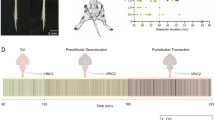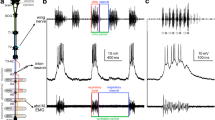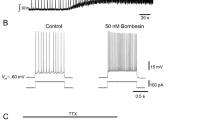Summary
In addition to the wellknown fictive locomotion, a fictive respiration can also be obtained in decorticate, unanaesthetized rabbit preparations after curarization and vagotomy.
Both patterns were abolished after high spinal (C2 or C3) transection. Spinal rhythmic capabilities could be disclosed after administration of nialamide and DOPA: together with the earlier demonstrated locomotor-like bursting in hindlimb and forelimb muscle nerves, two different types of phrenic bursting patterns could be observed, depending on endtidal CO2 levels: (1) short lasting phrenic bursts (SLPBs), coordinated with locomotor bursts, result of a locomotor driving process; (2) when end-tidal CO2 was slightly increased (4.5 instead of 4.0%), long lasting phrenic bursts (LLPBs) developed: they have no causal link with the locomotor bursts.
Intraspinal interactions were shown to operate between these rhythmic patterns: (1) the already mentioned caudo-rostral driving from hindlimb or posterior locomotion generators (pLGs) onto forelimb bursting and onto phrenic activity too (providing SLPBs in the latter case); (2) the rostro-caudal inhibition of fore- and hindlimb locomotor activity throughout each LLPB.
Since forelimb locomotor-like bursting and LLPBs could still be obtained after functional isolation of the cervico-thoracic cord (through C2 and Th12 spinal transections) with comparable interactions as before Th12 transection, it is concluded that: two categories of generators, forelimb or anterior locomotion generators (aLGs), and chemosensitive respiration generators (RGs) are both present in this part of the cord, on the one hand; interactions between RGs and pLGs are likely to be achieved via aLGs on the other.
Similar content being viewed by others
References
Anden NE, Fuxe K, Hokfelt T (1967) Effect of some drugs on central monoamine nerve terminals lacking nerve impulse flow. Eur J Pharmacol 1: 226–232
Aoki M, Mori S, Kawahara K, Watanabe H, Ebata N (1980) Generation of spontaneous respiratory rhythm in high spinal cats. Brain Res 202: 51–63
Batsel HL (1964) Localization of bulbar respiratory center by microelectrode sounding. Exp Neurol 9: 410–426
Bechbache RR, Duffin J (1977) The entrainment of breathing frequency by exercise rhythm. J Physiol (Lond) 272: 553–562
Bessou P, Dejours P, Laporte Y (1959) Effets ventilatoires réflexes de la stimulation de fibres afférentes de grand diamètre d'origine musculaire chez le chat. CR Soc Biol (Paris) 153: 477–481
Blanchi AL (1971) Localisation et étude des neurones respiratoires bulbaires. Mise en jeu antidromique par stimulation spinale ou vagale. J Physiol (Paris) 63: 5–40
Bradley GW, Euler C von, Marttila I, Roos B (1974a) Transient and steady state effects of CO2 on mechanisms determining rate and depth of breathing. Acta Physiol Scand 92: 341–350
Bradley GW, Euler C von, Marttila I, Roos B (1974b) Steady state effects of CO2 and temperature on the relationship between lung volume and inspiratory duration (Hering-Breuer threshold curve). Acta Physiol Scand 92: 351–363
Brown TG (1911) The intrinsic factors in the act of progression in the mammal. Proc R Soc Lond [Biol] 84: 308–319
Chatelier G, Buser P (1961) Dispositif de contention rigide du lapin pour exploration stéréotaxique. Electroencephalogr Clin Neurophysiol 13: 951–953
Coglianese CJ, Peiss CN, Wurster RD (1977) Rhythmic phrenic nerve activity and respiratory activity in spinal dogs. Respir Physiol 29: 247–254
Comroe J, Schmidt C (1943) Reflexes from the limb as a factor in the hyperpnea of muscular exercise. Am J Physiol 138: 536–547
Euler C von, Herero F, Wexler I (1970) Control mechanisms determining rate and depth of respiratory movements. Respir Physiol 10: 93–108
Frankstein SI, Lisin W, Sergeeva LN (1974) Is there a special pace-maker for stepping? Experientia 30: 1414–1415
Gautier H, Lacaisse A, Dejours P (1969) Ventilatory response to muscle spindle stimulation by succinylcholine in cats. Respir Physiol 7: 383–388
Grillner S, Zangger P (1974) Locomotor movements generated by the deafferented spinal cord. Acta Physiol Scand 91: 38A-39A
Grunstein MM, Younes M, Milic-Emili J (1973) Control of tidal volume and respiratory frequency in anesthetized cats. J Appl Physiol 35: 463–476
Harrison T, Harrison W, Calhoun J, Marsh JP (1932) Congestive heart failure. XVII. Mechanism of dyspnea on exertion. Arch Intern Med 50: 690–720
Hoff HE, Breckenridge CG (1949) The medullary origin of respiratory periodicity in the dog. Am J Physiol 158: 157–172
Holst E von (1939) Die relative Koordination als Phenomen und als Methode zentralnervöser Funktionsanalyse. Ergeb Physiol 42: 288–306
Holst E von (1973) The behavioral physiology of animals and man: The collected papers of Erich von Holst, vol 1. Methuen, London
Langendorff O, Nitschmann R (1880) Studien über die Innervation der Athembewegungen. I. Über die spinalen Zentren der Athmung. Arch Physiol 4: 518–549
Jankowska E, Jukes MG, Lund S, Lundberg A (1967) The effect of DOPA on the spinal cord: 5. Reciprocal organization of pathways transmitting excitatory action to alpha motoneurones of flexors and extensors. Acta Physiol Scand 70: 369–388
Langworthy OR (1924) A physiological study of the reactions of young decerebrate mammals. Am J Physiol 69: 254–264
Le Mare DW (1936) Reflex and rhythmical movements of the dogfish. J Exp Biol 13: 429–442
Nelson JR (1959) Single unit activity in medullary respiration centers of cat. J Neurophysiol 22: 590–598
Orlovsky GN (1970) Influence of the cerebellum on the reticulospinal neurones during locomotion. Biophysics 15: 928–936
Orlovsky GN, Pavlova GA (1972) Effect of removal of the cerebellum on vestibular responses of neurons and various descending tracts in cats. Neurophysiol 4: 235–240
Rikard-Bell GC, Bystrzycka EK (1980) Localization of phrenic motor nucleus in the cat and rabbit studied with horseradish peroxidase. Brain Res 194: 479–483
Robertson RM, Moulins M (1981) Control of rhythmic behaviour by a hierarchy of linked oscillators in Crustacea. Neurosci Lett 21: 111–116
Salmoiraghi GC, Burns BD (1960) Notes on mechanism of rhythmic respiration. J Neurophysiol 23: 14–26
Viala D, Buser P (1971) Modalités d'obtention de rythmes locomoteurs chez le lapin spinal par traitements pharmacologiques (DOPA, 5-HTP, D-amphétamine). Brain Res 35: 151–165
Viala D, Freton E (1980) Mise en évidence de générateurs de rythmes locomoteurs et de rythmes “respiratoires” dans la moelle cervico-thoracique du lapin. CR Seances Acad Sci (Serie D) 291: 573–576
Viala D, Vidal C (1978) Evidence for distinct spinal locomotion generators supplying respectively fore- and hindlimbs in the rabbit. Brain Res 155: 182–186
Viala D, Vidal C, Freton E (1979) Coordinated rhythmic bursting in respiratory and locomotor muscle nerves in the spinal rabbit. Neurosci Lett 11: 155–159
Wang SC, Ngai SH, Frumin MJ (1957) Organization of central respiratory mechanisms in the brain stem of the cat: Genesis of normal respiratory rhythmicity. Am J Physiol 190: 333–342
Author information
Authors and Affiliations
Additional information
Supported by the C.N.R.S. (E.R.A. 411 and A.T.P. 3619), the D.G.R.S.T. (D.N. 78-7-2789) and the Fondation pour la Recherche Médicale
Rights and permissions
About this article
Cite this article
Viala, D., Freton, E. Evidence for respiratory and locomotor pattern generators in the rabbit cervico-thoracic cord and for their interactions. Exp Brain Res 49, 247–256 (1983). https://doi.org/10.1007/BF00238584
Received:
Issue Date:
DOI: https://doi.org/10.1007/BF00238584




